Zeeshan Hayder
UniHM: Universal Human Motion Generation with Object Interactions in Indoor Scenes
May 19, 2025Abstract:Human motion synthesis in complex scenes presents a fundamental challenge, extending beyond conventional Text-to-Motion tasks by requiring the integration of diverse modalities such as static environments, movable objects, natural language prompts, and spatial waypoints. Existing language-conditioned motion models often struggle with scene-aware motion generation due to limitations in motion tokenization, which leads to information loss and fails to capture the continuous, context-dependent nature of 3D human movement. To address these issues, we propose UniHM, a unified motion language model that leverages diffusion-based generation for synthesizing scene-aware human motion. UniHM is the first framework to support both Text-to-Motion and Text-to-Human-Object Interaction (HOI) in complex 3D scenes. Our approach introduces three key contributions: (1) a mixed-motion representation that fuses continuous 6DoF motion with discrete local motion tokens to improve motion realism; (2) a novel Look-Up-Free Quantization VAE (LFQ-VAE) that surpasses traditional VQ-VAEs in both reconstruction accuracy and generative performance; and (3) an enriched version of the Lingo dataset augmented with HumanML3D annotations, providing stronger supervision for scene-specific motion learning. Experimental results demonstrate that UniHM achieves comparative performance on the OMOMO benchmark for text-to-HOI synthesis and yields competitive results on HumanML3D for general text-conditioned motion generation.
MoKD: Multi-Task Optimization for Knowledge Distillation
May 13, 2025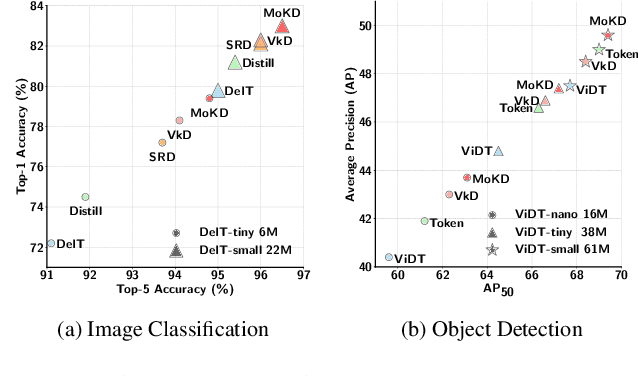
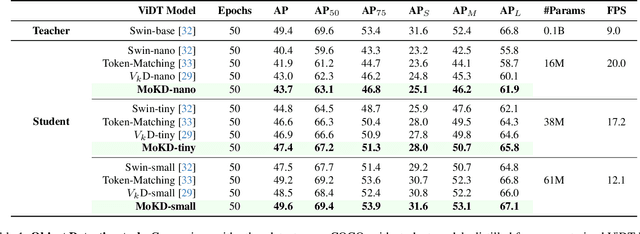
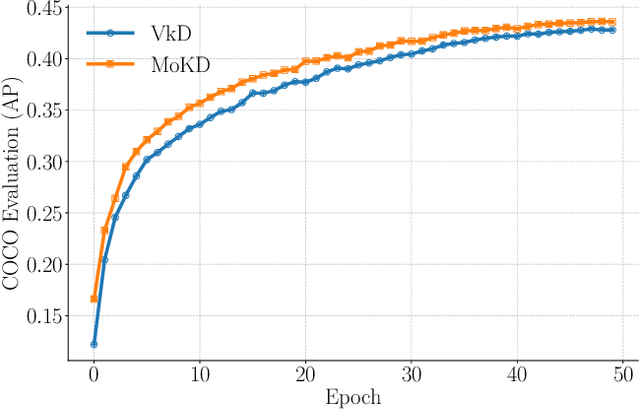
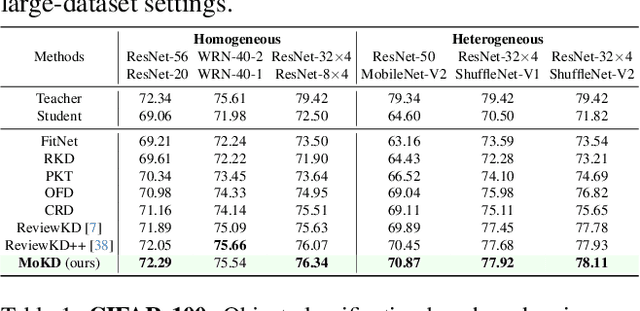
Abstract:Compact models can be effectively trained through Knowledge Distillation (KD), a technique that transfers knowledge from larger, high-performing teacher models. Two key challenges in Knowledge Distillation (KD) are: 1) balancing learning from the teacher's guidance and the task objective, and 2) handling the disparity in knowledge representation between teacher and student models. To address these, we propose Multi-Task Optimization for Knowledge Distillation (MoKD). MoKD tackles two main gradient issues: a) Gradient Conflicts, where task-specific and distillation gradients are misaligned, and b) Gradient Dominance, where one objective's gradient dominates, causing imbalance. MoKD reformulates KD as a multi-objective optimization problem, enabling better balance between objectives. Additionally, it introduces a subspace learning framework to project feature representations into a high-dimensional space, improving knowledge transfer. Our MoKD is demonstrated to outperform existing methods through extensive experiments on image classification using the ImageNet-1K dataset and object detection using the COCO dataset, achieving state-of-the-art performance with greater efficiency. To the best of our knowledge, MoKD models also achieve state-of-the-art performance compared to models trained from scratch.
Auto-Regressive Diffusion for Generating 3D Human-Object Interactions
Mar 21, 2025Abstract:Text-driven Human-Object Interaction (Text-to-HOI) generation is an emerging field with applications in animation, video games, virtual reality, and robotics. A key challenge in HOI generation is maintaining interaction consistency in long sequences. Existing Text-to-Motion-based approaches, such as discrete motion tokenization, cannot be directly applied to HOI generation due to limited data in this domain and the complexity of the modality. To address the problem of interaction consistency in long sequences, we propose an autoregressive diffusion model (ARDHOI) that predicts the next continuous token. Specifically, we introduce a Contrastive Variational Autoencoder (cVAE) to learn a physically plausible space of continuous HOI tokens, thereby ensuring that generated human-object motions are realistic and natural. For generating sequences autoregressively, we develop a Mamba-based context encoder to capture and maintain consistent sequential actions. Additionally, we implement an MLP-based denoiser to generate the subsequent token conditioned on the encoded context. Our model has been evaluated on the OMOMO and BEHAVE datasets, where it outperforms existing state-of-the-art methods in terms of both performance and inference speed. This makes ARDHOI a robust and efficient solution for text-driven HOI tasks
NeFF-BioNet: Crop Biomass Prediction from Point Cloud to Drone Imagery
Oct 30, 2024Abstract:Crop biomass offers crucial insights into plant health and yield, making it essential for crop science, farming systems, and agricultural research. However, current measurement methods, which are labor-intensive, destructive, and imprecise, hinder large-scale quantification of this trait. To address this limitation, we present a biomass prediction network (BioNet), designed for adaptation across different data modalities, including point clouds and drone imagery. Our BioNet, utilizing a sparse 3D convolutional neural network (CNN) and a transformer-based prediction module, processes point clouds and other 3D data representations to predict biomass. To further extend BioNet for drone imagery, we integrate a neural feature field (NeFF) module, enabling 3D structure reconstruction and the transformation of 2D semantic features from vision foundation models into the corresponding 3D surfaces. For the point cloud modality, BioNet demonstrates superior performance on two public datasets, with an approximate 6.1% relative improvement (RI) over the state-of-the-art. In the RGB image modality, the combination of BioNet and NeFF achieves a 7.9% RI. Additionally, the NeFF-based approach utilizes inexpensive, portable drone-mounted cameras, providing a scalable solution for large field applications.
Text-guided 3D Human Motion Generation with Keyframe-based Parallel Skip Transformer
May 24, 2024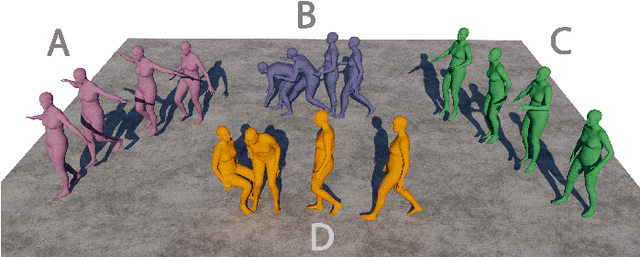
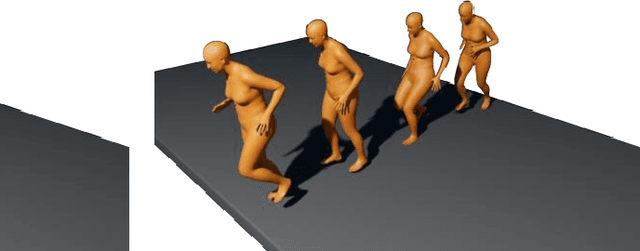
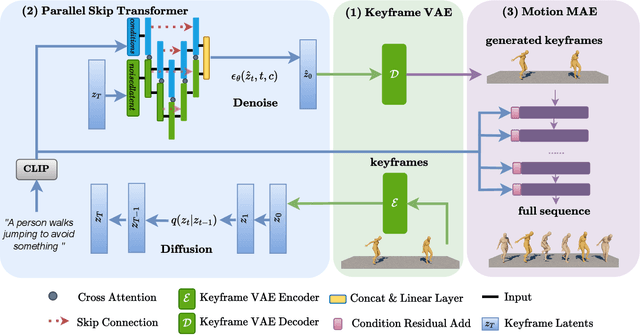
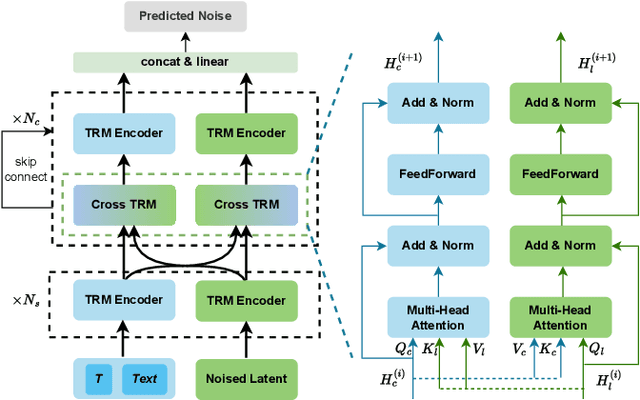
Abstract:Text-driven human motion generation is an emerging task in animation and humanoid robot design. Existing algorithms directly generate the full sequence which is computationally expensive and prone to errors as it does not pay special attention to key poses, a process that has been the cornerstone of animation for decades. We propose KeyMotion, that generates plausible human motion sequences corresponding to input text by first generating keyframes followed by in-filling. We use a Variational Autoencoder (VAE) with Kullback-Leibler regularization to project the keyframes into a latent space to reduce dimensionality and further accelerate the subsequent diffusion process. For the reverse diffusion, we propose a novel Parallel Skip Transformer that performs cross-modal attention between the keyframe latents and text condition. To complete the motion sequence, we propose a text-guided Transformer designed to perform motion-in-filling, ensuring the preservation of both fidelity and adherence to the physical constraints of human motion. Experiments show that our method achieves state-of-theart results on the HumanML3D dataset outperforming others on all R-precision metrics and MultiModal Distance. KeyMotion also achieves competitive performance on the KIT dataset, achieving the best results on Top3 R-precision, FID, and Diversity metrics.
MMCBE: Multi-modality Dataset for Crop Biomass Estimation and Beyond
Apr 17, 2024Abstract:Crop biomass, a critical indicator of plant growth, health, and productivity, is invaluable for crop breeding programs and agronomic research. However, the accurate and scalable quantification of crop biomass remains inaccessible due to limitations in existing measurement methods. One of the obstacles impeding the advancement of current crop biomass prediction methodologies is the scarcity of publicly available datasets. Addressing this gap, we introduce a new dataset in this domain, i.e. Multi-modality dataset for crop biomass estimation (MMCBE). Comprising 216 sets of multi-view drone images, coupled with LiDAR point clouds, and hand-labelled ground truth, MMCBE represents the first multi-modality one in the field. This dataset aims to establish benchmark methods for crop biomass quantification and foster the development of vision-based approaches. We have rigorously evaluated state-of-the-art crop biomass estimation methods using MMCBE and ventured into additional potential applications, such as 3D crop reconstruction from drone imagery and novel-view rendering. With this publication, we are making our comprehensive dataset available to the broader community.
Backpropagation-free Network for 3D Test-time Adaptation
Mar 27, 2024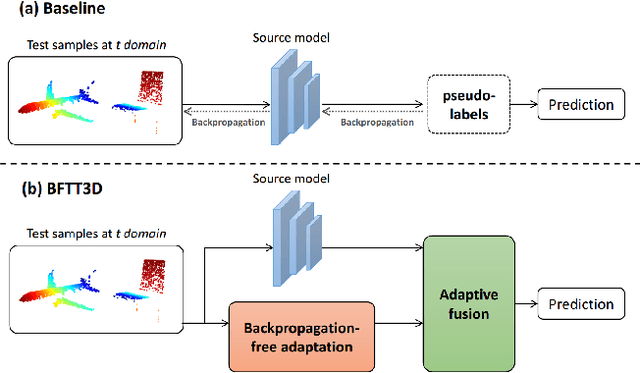

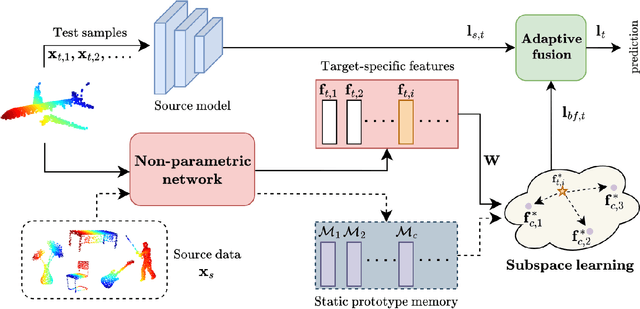

Abstract:Real-world systems often encounter new data over time, which leads to experiencing target domain shifts. Existing Test-Time Adaptation (TTA) methods tend to apply computationally heavy and memory-intensive backpropagation-based approaches to handle this. Here, we propose a novel method that uses a backpropagation-free approach for TTA for the specific case of 3D data. Our model uses a two-stream architecture to maintain knowledge about the source domain as well as complementary target-domain-specific information. The backpropagation-free property of our model helps address the well-known forgetting problem and mitigates the error accumulation issue. The proposed method also eliminates the need for the usually noisy process of pseudo-labeling and reliance on costly self-supervised training. Moreover, our method leverages subspace learning, effectively reducing the distribution variance between the two domains. Furthermore, the source-domain-specific and the target-domain-specific streams are aligned using a novel entropy-based adaptive fusion strategy. Extensive experiments on popular benchmarks demonstrate the effectiveness of our method. The code will be available at https://github.com/abie-e/BFTT3D.
DSGG: Dense Relation Transformer for an End-to-end Scene Graph Generation
Mar 21, 2024Abstract:Scene graph generation aims to capture detailed spatial and semantic relationships between objects in an image, which is challenging due to incomplete labelling, long-tailed relationship categories, and relational semantic overlap. Existing Transformer-based methods either employ distinct queries for objects and predicates or utilize holistic queries for relation triplets and hence often suffer from limited capacity in learning low-frequency relationships. In this paper, we present a new Transformer-based method, called DSGG, that views scene graph detection as a direct graph prediction problem based on a unique set of graph-aware queries. In particular, each graph-aware query encodes a compact representation of both the node and all of its relations in the graph, acquired through the utilization of a relaxed sub-graph matching during the training process. Moreover, to address the problem of relational semantic overlap, we utilize a strategy for relation distillation, aiming to efficiently learn multiple instances of semantic relationships. Extensive experiments on the VG and the PSG datasets show that our model achieves state-of-the-art results, showing a significant improvement of 3.5\% and 6.7\% in mR@50 and mR@100 for the scene-graph generation task and achieves an even more substantial improvement of 8.5\% and 10.3\% in mR@50 and mR@100 for the panoptic scene graph generation task. Code is available at \url{https://github.com/zeeshanhayder/DSGG}.
RG-CAT: Detection Pipeline and Catalogue of Radio Galaxies in the EMU Pilot Survey
Mar 21, 2024Abstract:We present source detection and catalogue construction pipelines to build the first catalogue of radio galaxies from the 270 $\rm deg^2$ pilot survey of the Evolutionary Map of the Universe (EMU-PS) conducted with the Australian Square Kilometre Array Pathfinder (ASKAP) telescope. The detection pipeline uses Gal-DINO computer-vision networks (Gupta et al., 2024) to predict the categories of radio morphology and bounding boxes for radio sources, as well as their potential infrared host positions. The Gal-DINO network is trained and evaluated on approximately 5,000 visually inspected radio galaxies and their infrared hosts, encompassing both compact and extended radio morphologies. We find that the Intersection over Union (IoU) for the predicted and ground truth bounding boxes is larger than 0.5 for 99% of the radio sources, and 98% of predicted host positions are within $3^{\prime \prime}$ of the ground truth infrared host in the evaluation set. The catalogue construction pipeline uses the predictions of the trained network on the radio and infrared image cutouts based on the catalogue of radio components identified using the Selavy source finder algorithm. Confidence scores of the predictions are then used to prioritize Selavy components with higher scores and incorporate them first into the catalogue. This results in identifications for a total of 211,625 radio sources, with 201,211 classified as compact and unresolved. The remaining 10,414 are categorized as extended radio morphologies, including 582 FR-I, 5,602 FR-II, 1,494 FR-x (uncertain whether FR-I or FR-II), 2,375 R (single-peak resolved) radio galaxies, and 361 with peculiar and other rare morphologies. We cross-match the radio sources in the catalogue with the infrared and optical catalogues, finding infrared cross-matches for 73% and photometric redshifts for 36% of the radio galaxies.
Deep Learning Approaches for Seizure Video Analysis: A Review
Dec 18, 2023
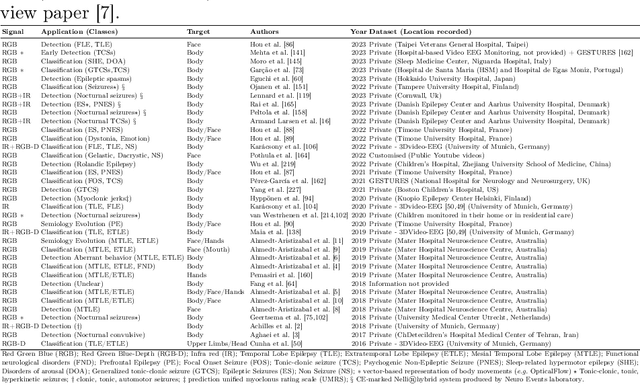

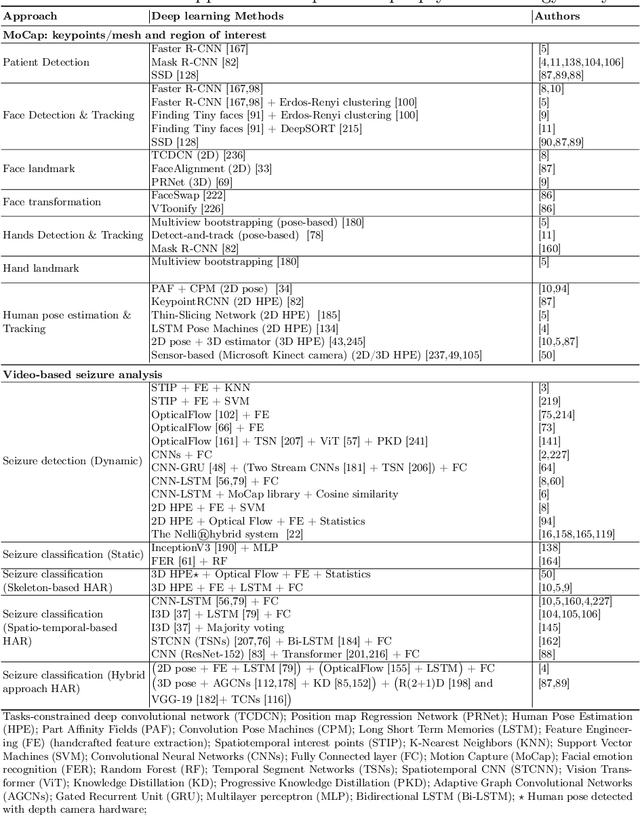
Abstract:Seizure events may manifest as transient disruptions in movement and behavior, and the analysis of these clinical signs, referred to as semiology, is subject to observer variations when specialists evaluate video-recorded events in the clinical setting. To enhance the accuracy and consistency of evaluations, computer-aided video analysis of seizures has emerged as a natural avenue. In the field of medical applications, deep learning and computer vision approaches have driven substantial advancements. Historically, these approaches have been used for disease detection, classification, and prediction using diagnostic data; however, there has been limited exploration of their application in evaluating video-based motion detection in the clinical epileptology setting. While vision-based technologies do not aim to replace clinical expertise, they can significantly contribute to medical decision-making and patient care by providing quantitative evidence and decision support. Behavior monitoring tools offer several advantages such as providing objective information, detecting challenging-to-observe events, reducing documentation efforts, and extending assessment capabilities to areas with limited expertise. In this paper, we detail the foundation technologies used in vision-based systems in the analysis of seizure videos, highlighting their success in semiology detection and analysis, focusing on work published in the last 7 years. We systematically present these methods and indicate how the adoption of deep learning for the analysis of video recordings of seizures could be approached. Additionally, we illustrate how existing technologies can be interconnected through an integrated system for video-based semiology analysis. Finally, we discuss challenges and research directions for future studies.
 Add to Chrome
Add to Chrome Add to Firefox
Add to Firefox Add to Edge
Add to Edge